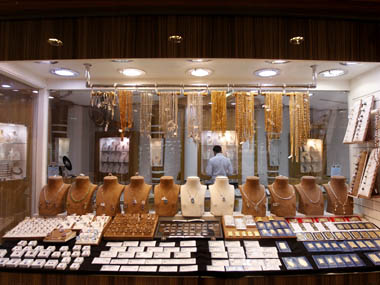It may be too early to conclude that the recent fall in gold prices will have a positive impact on the yawning current account deficit, an HSBC report has said. This is because the high price sensitivity of demand may actually increase Indians’ demand for gold and eventually end up with little or no impact on the Current account deficit (CAD). Lower inflation and wage growth would matter more in bridging CAD, the report says.
The run-up in gold imports following the global financial crisis in 2008-09 has been quite significant. This run-up, the report says, has been driven by strong real wage growth, especially in rural areas. The rise in inflation and, consequently, the erosion of real returns on deposits, also encouraged more gold buying.
[caption id=“attachment_738097” align=“alignleft” width=“380”] The HSBC analysis shows that while a decline in gold prices would be counterbalanced by an increase in demand for the yellow metal, other factors are likely to help lower the large gold import bill when measured against gross domestic product. Reuters[/caption]
“Our quantitative analysis supports this, showing that the volume of gold imports rises with higher real incomes, lower real deposit rates, and falling gold prices. In fact, the volume demand for gold is price sensitive, and we, therefore, find that the recent drop in gold prices is likely to have no impact on the current account deficit as the drop in prices should be outweighed by a rise in volumes. The expected decline in inflation and real wage growth should, however, help narrow the CA deficit slightly,” the report says.
The HSBC analysis shows that while a decline in gold prices would be counterbalanced by an increase in demand for the yellow metal, other factors are likely to help lower the large gold import bill when measured against gross domestic product (GDP). The consumption demand for gold is likely to decelerate due to somewhat slower income growth on the back of deceleration in growth and the gradual easing in inflation pressures. This apart, improving real returns on bank deposits as inflation eases should also help dampen demand for gold.
The bank says the implication of the analysis for policymakers is that they should not just rely on lower gold prices to take care of the current account deficit. Since they cannot really control gold prices, what policymakers have more control over are the other key factors driving the demand for gold.
Among the steps it advocates is getting inflation down as this would help lower wage pressures and raise real deposit rates. It will also be important to further develop saving instruments to provide alternatives to holding gold, including instruments protecting against inflation or linked to the price of gold. Further efforts to provide the rural population access to banking could also help reduce excessive demand, the report says.
Gold prices have fallen over 10 percent since last year, lifting sentiment in India, which is the world’s largest gold importer. Policymakers have, for long, been concerned about the hefty gold imports and the concomitant effect on the CAD. The CA deficit has been very high, at 5.1 percent of GDP in 2012, with gold imports alone accounting for 2.9 percent of GDP.


)
)
)
)
)
)
)
)
)



